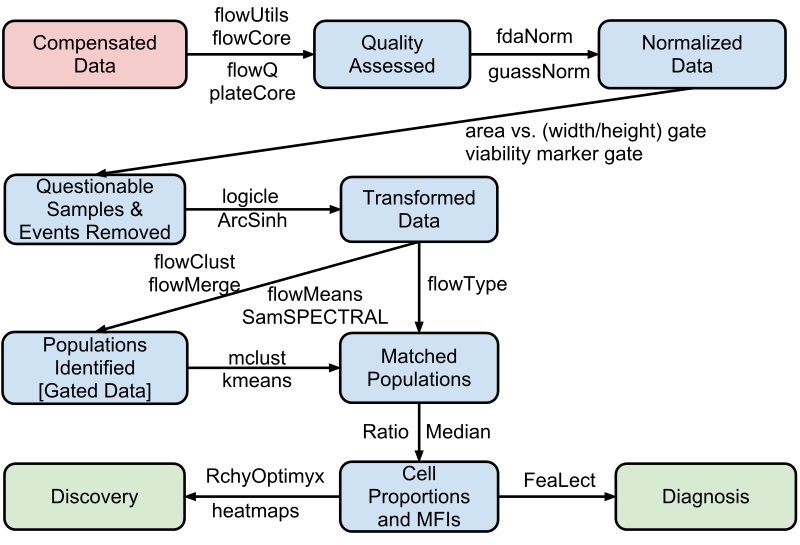Definition
Flow Cytometry is a process used to analyze cell characteristics. Using a laser and fluorescently tagged proteins, parameters such as cell size, health, and phenotype can be determined. Flow cytometry is so refined that individual proteins can be tracked. Thus, we can analyze a cell’s inner workings and signaling networks.
Flow Cytometry Explained
Flow cytometry can use either laser light or electrical impedance (an electronic measure of the opposition of current in an AC circuit), it runs on the same principle. Cells are suspended in a stream of fluid and, one at a time, are passed through a focus of exciting light.
Since the proteins or cell components of interest have been fluorescently labeled with antibodies, the emitting light will scatter into distinct wavelengths that are read by an electronic detection apparatus. It then translates the scattered light into the quantifiable physical and chemical traits of the particles in the fluid. This ability earns flow cytometry its place as an essential biomedical tool for analyzing cells and their components.
Flow Cytometry Protocol
While laboratories around the world continue to optimize flow cytometry protocol, it conventionally includes the following steps:
- Cells are fixed with formaldehyde to immobilize the proteins of interest and their transient signaling events.
- Methanol or detergent is added to the test tube to make cells permeable to antibodies that can then enter their intracellular spaces.
- Fluorescently tagged antibodies are added and must be chosen carefully to allow optimal targeting of the epitopes and proper antigen detection when staining multiple surface and intracellular proteins, simultaneously.
- The test tube is placed in the flow cytometer and the fluid is allowed to reach – and then exit through – the flow chamber, one cell at a time.
- As each cell crosses the laser beam, the light that bounces off it is transmitted to light/color detectors.
- The data retrieved from this experiment can finally undergo analysis to unravel the unique facets of the cells themselves and their patterns of cell signaling.
The antibody staining can vary, as well:
- With direct staining, cells are incubated with an antibody directly conjugated to a fluorochrome (e.g., FITC). This is a one-step incubation and is particularly useful for intracellular staining.
- In indirect staining, the primary antibody is not labeled but is instead detected by a fluorochrome-labeled secondary antibody. This method means unconjugated primary antibodies can be raised against many different targets, which widens the choice of target proteins for the researcher.
- Intracellular staining refers to a stain of intracellular antigens.
- Finally, proteins secreted by a cell can be tagged and traced with a Golgi block, followed by intracellular staining.
Flow Cytometry Test
Flow cytometry has a great variety of uses. In its simplest application, it can count cells as each crosses the laser beam. Flow cytometry can also sort cells from heterogeneous mixtures by correlating the light signals they emit to known cell morphology and gene expression patterns.
A lot can be said about the emitting particles themselves. Flow cytometry can reveal a particle’s size, granularity, and fluorescent intensity. It is also useful in detecting biomarkers that are important in understanding disease. In fact, we can use more than one cell-type specific marker combined with phosphorylated-epitopes to provide a unique way of understanding signaling biomarkers in cell mixtures.
More basic applications of flow cytometry include studies in:
- Cell tracking
- Cell cycle and Apoptosis (“cell death”)
- Phenotyping
- Signal Transduction
Decoding signaling patterns also carries great therapeutic significance. Normal patterns can reveal how drugs work, and uncovering disruptions in normal signaling can lend us insight on how a disease develops. This affords flow cytometry perhaps its most important role in diagnostic testing.
Flow Cytometry Analysis
Flow cytometry has become something of a golden standard in pathology. It has been used in fields as diverse as marine science and plant biology but has gained more popularity for its clinical applications in oncology, immunodeficiency disorders, and prenatal diagnostics.

Flow cytometry is extremely important in modern cancer research. By staining for specific surface antigens, flow cytometry allows us to discern between different cancer cell types in the lymph node, bone marrow, and blood samples collected from a patient. For example, lymphoma can often be diagnosed using flow cytometry. Likewise, this tool can evaluate the risk of recurrence of bladder, breast, and prostate cancers by measuring the amount of light-reactive DNA found in cancer cells. This is clearly a crucial tool for the millions of cancer survivors who are in remission each year.
Its applications in diagnosing primary immunodeficiency (PI) diseases are just as potent. PI diseases are a group of rare, chronic disorders that compromise the affected patient’s immune system from fighting infections. These infections are recurring and may affect the patient’s skin, lungs, throat, brain, or even gastrointestinal and urinary tracts. While diagnosing PI disorders requires several tests, flow cytometry is a key part of the initial workup and subsequent management.
All in all, the diverse applications of flow cytometry make its use very promising, and it is predicted to feature prominently in routine hospital and clinic visits for years to come.
Quiz
